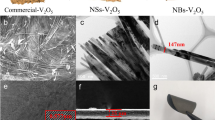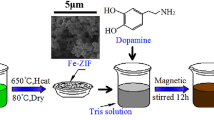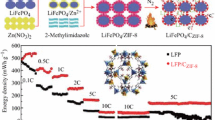Abstract
Thin-film electrodes were prepared using a one-step drop-casting strategy without polymer binder and carbon black. The electrodes exhibit a thin-layer structure, which is an intriguing architecture for lithium-ion battery applications. A high reversible capacity (335.3 and 311.6 mAh g−1 for ZIF-8 and ZIF-67, respectively), good rate performance, and exceptionally cycling stability (about 95.5% initial capacity was retained after 100 cycles at a high current rate of 5 C) were observed in this study. Such an excellent electrochemical performance of the film electrodes is attributed to the thin-layer architecture, which provides easy access for Li+ ions to permeate the whole electrodes because of the shortened diffusion paths, and also to the unique property of the MOFs without the collapse of its structure.










Similar content being viewed by others
References
Xu X, Cao R, Jeong S, Cho J (2012) Spindle-like mesoporous alpha-Fe2O3 anode material prepared from MOF template for high-rate lithium batteries. Nano Lett 12:4988–4991. doi:10.1021/nl302618s
Yim C-H, Baranova EA, Courtel FM, Abu-Lebdeh Y, Davidson IJ (2011) Synthesis and characterization of macroporous tin oxide composite as an anode material for Li-ion batteries. J Power Sources 196:9731–9736. doi:10.1016/j.jpowsour.2011.07.061
Liu X, Zhao J, Hao J, Su B-L, Li Y (2013) 3D ordered macroporous germanium fabricated by electrodeposition from an ionic liquid and its lithium storage properties. J Mater Chem A 1:15076–15081. doi:10.1039/c3ta12923c
Maiti S, Pramanik A, Manju U, Mahanty S (2015) Reversible lithium storage in manganese 1,3,5-benzenetricarboxylate metal-organic framework with high capacity and rate performance. ACS Appl Mater Interfaces 7:16357–16363. doi:10.1021/acsami.5b03414
Furukawa H, Cordova KE, O’Keeffe M, Yaghi OM (2013) The chemistry and applications of metal-organic frameworks. Science 341:1230444–1230456. doi:10.1126/science.1230444
Gao Y, Wu J, Zhang W, Tan Y, Gao J, Tang B, Zhao J (2015) Synthesis of nickel carbonate hydroxide@zeolitic imidazolate framework-67 (Ni2CO3(OH)2@ZIF-67) for pseudocapacitor applications. J Appl Electrochem 45:541–547. doi:10.1007/s10800-015-0795-2
Han Y, Qi P, Li S, Feng X, Zhou J, Li H, Su S, Li X, Wang B (2014) A novel anode material derived from organic-coated ZIF-8 nanocomposites with high performance in lithium ion batteries. Chem Commun 50:8057–8060. doi:10.1039/c4cc02691h
Han X, Yi F, Sun T, Sun J (2012) Synthesis and electrochemical performance of Li and Ni 1,4,5,8-naphthalenetetracarboxylates as anodes for Li-ion batteries. Electrochem Commun 25:136–139. doi:10.1016/j.elecom.2012.09.014
Férey G, Millange F, Morcrette M, Serre C, Doublet M-L, Grenèche J-M, Tarascon J-M (2007) Mixed-valence Li/Fe-based metal–organic frameworks with both reversible redox and sorption properties. Angew Chem Int Edit 46:3259–3263. doi:10.1002/anie.200605163
Saravanan K, Nagarathinam M, Balaya P, Vittal JJ (2010) Lithium storage in a metal organic framework with diamondoid topology—a case study on metal formates. J Mater Chem 20:8329–8335. doi:10.1039/c0jm01671c
Lin YZ, Zhang Q, Zhao C, Li H, Kong C, Shen C, Chen L (2015) An exceptionally stable functionalized metal-organic framework for lithium storage. Chem Commun 51:697–699. doi:10.1039/c0xx00000x
Zhao Y, Song Z, Li X, Sun Q, Cheng N, Lawes S, Sun X (2016) Metal organic frameworks for energy storage and conversion. Energy Storage Mater 2:35–62. doi:10.1016/j.ensm.2015.11.005
Ameloot R, Aubrey M, Wiers BM, Gomora-Figueroa AP, Patel SN, Balsara NP, Long JR (2013) Ionic conductivity in the metal–organic framework UiO-66 by dehydration and insertion of lithium tert-butoxide. Chem-Eur J 19:5533–5536. doi:10.1002/chem.201300326
Gao Y, Wu J, Zhang W, Tan Y, Gao J, Zhao J, Tang B (2014) The calcined zeolitic imidazolate framework-8 (ZIF-8) under different conditions as electrode for supercapacitor applications. J Solid State Electrochem 18:3203–3207. doi:10.1007/s10008-014-2578-9
Worrall SD, Mann H, Rogers A, Bissett MA, Attfield MP, Dryfe RAW (2016) Electrochemical deposition of zeolitic imidazolate framework electrode coatings for supercapacitor electrodes. Electrochim Acta 197:228–240. doi:10.1016/j.electacta.2016.02.145
Zhang G, Hou S, Zhang H, Zeng W, Yan F, Li CC, Duan H (2015) High-performance and ultra-stable lithium-ion batteries based on MOF-derived ZnO@ZnO quantum dots/C core-shell nanorod arrays on a carbon cloth anode. Adv Mater 27:2400–2405. doi:10.1002/adma.201405222
Wang N, Wu C, Li J, Dong G, Guan L (2011) Binder-free manganese oxide/carbon nanomaterials thin film electrode for supercapacitors. ACS Appl Mater Interfaces 3:4185–4189. doi:10.1021/am201145k
Tian B, Światowska J, Maurice V, Zanna S, Seyeux A, Klein LH, Marcus P (2013) Combined surface and electrochemical study of the lithiation/delithiation mechanism of the iron oxide thin-film anode for lithium-ion batteries. J Phys Chem C 117:21651–21661. doi:10.1021/jp4064438
Stassen I, Styles M, Van Assche T, Campagnol N, Fransaer J, Denayer J, Tan J-C, Falcaro P, De Vos D, Ameloot R (2015) Electrochemical film deposition of the zirconium metal–organic framework UiO-66 and application in a miniaturized sorbent trap. Chem Mater 27:1801–1807. doi:10.1021/cm504806p
Yiping T, Xiaoxu T, Guangya H, Guoqu Z (2014) Nanocrystalline Li4Ti5O12-coated TiO2 nanotube arrays as three-dimensional anode for lithium-ion batteries. Electrochim Acta 117:172–178. doi:10.1016/j.electacta.2013.11.095
Qian J, Sun F, Qin L (2012) Hydrothermal synthesis of zeolitic imidazolate framework-67 (ZIF-67) nanocrystals. Mater Lett 82:220–223. doi:10.1016/j.matlet.2012.05.077
Torad NL, Hu M, Kamachi Y, Takai K, Imura M, Naito M, Yamauchi Y (2013) Facile synthesis of nanoporous carbons with controlled particle sizes by direct carbonization of monodispersed ZIF-8 crystals. Chem Commun 49:2521–2523. doi:10.1039/c3cc38955c
Lee DY, Yoon SJ, Shrestha NK, Lee S-H, Ahn H, Han S-H (2012) Unusual energy storage and charge retention in Co-based metal–organic-frameworks. Micropor Mesopor Mater 153:163–165. doi:10.1016/j.micromeso.2011.12.040
Kruk M, Jaroniec M (2001) Gas adsorption characterization of ordered organic − inorganic nanocomposite materials. Chem Mater 13:3169–3183. doi:10.1021/cm0101069
Park KS, Ni Z, Cote AP, Choi JY, Huang R, Uribe-Romo FJ, Chae HK, O’Keeffe M, Yaghi OM (2006) Exceptional chemical and thermal stability of zeolitic imidazolate frameworks. Proc Natl Acad Sci USA 103:10186–10191. doi:10.1073/pnas.0602439103
Banerjee R, Phan A, Wang B, Knobler C, Furukawa H, O’Keeffe M, Yaghi OM (2008) High-throughput synthesis of zeolitic imidazolate frameworks and application to CO2 capture. Science 319:939–943. doi:10.1126/science.1152516
Aurbach D, Markovsky B, Weissman I, Levi E, Ein-Eli Y (1999) On the correlation between surface chemistry and performance of graphite negative electrodes for Li ion batteries. Electrochim Acta 45:67–86. doi:10.1016/s0013-4686(99)00194-2
Eriksson T, Andersson AM, Bishop AG, Gejke C, Tr Gustafsson, Thomas JO (2002) Surface analysis of LiMn[sub 2]O[sub 4] electrodes in carbonate-based electrolytes. J Electrochem Soc 149(1):A69–A78. doi:10.1149/1.1426398
Eshkenazi V, Peled E, Burstein L, Golodnitsky D (2004) XPS analysis of the SEI formed on carbonaceous materials. Solid State Ionics 170:83–91. doi:10.1016/s0167-2738(03)00107-3
L-j Huang, B-j Li, N-f Ren (2016) Enhancing optical and electrical properties of Al-doped ZnO coated polyethylene terephthalate substrates by laser annealing using overlap rate controlling strategy. Ceram Int 42:7246–7252. doi:10.1016/j.ceramint.2016.01.118
Mannan TM, Soares JBP, Berry RM, Hamad WY (2016) In-situ production of polyethylene/cellulose nanocrystal composites. Can J Chem Eng 94:2107–2113. doi:10.1002/cjce.22608
Tang B, Huang S, Fang Y, Hu J, Malonzo C, Truhlar DG, Stein A (2016) Mechanism of electrochemical lithiation of a metal-organic framework without redox-active nodes. J Chem Phys 144:194702–194705. doi:10.1063/1.4948706
Liu Q, Yu L, Wang Y, Ji Y, Horvat J, Cheng ML, Jia X, Wang G (2013) Manganese-based layered coordination polymer: synthesis, structural characterization, magnetic property, and electrochemical performance in lithium-ion batteries. Inorg Chem 52:2817–2822. doi:10.1021/ic301579g
Liu Y, Bai J, Ma X, Li J, Xiong S (2014) Formation of quasi-mesocrystal ZnMn2O4 twin microspheres via an oriented attachment for lithium-ion batteries. J Mater Chem A 2:14236–14244. doi:10.1039/c4ta02950j
Cherian CT, Sundaramurthy J, Reddy MV, Suresh Kumar P, Mani K, Pliszka D, Sow CH, Ramakrishna S, Chowdari BV (2013) Morphologically robust NiFe2O4 nanofibers as high capacity Li-ion battery anode material. ACS Appl Mater Interfaces 5:9957–9963. doi:10.1021/am401779p
Worrall SD, Bissett MA, Hirunpinyopas W, Attfield MP, Dryfe RAW (2016) Facile fabrication of metal–organic framework HKUST-1-based rewritable data storage devices. J Mater Chem C 4:8687–8695. doi:10.1039/c6tc03496a
Bissett MA, Kinloch IA, Dryfe RA (2015) Characterization of MoS2-graphene composites for high-performance coin cell supercapacitors. ACS Appl Mater Interfaces 7(31):17388–17398. doi:10.1021/acsami.5b04672
Li Y, Trujillo MA, Fu E, Patterson B, Fei L, Xu Y, Deng S, Smirnov S, Luo H (2013) Bismuth oxide: a new lithium-ion battery anode. J Mater Chem A 1:12123–12127. doi:10.1039/C3TA12655B
Tonti D, MaJ Torralvo, Enciso E, Sobrados I, Sanz J (2008) Three-dimensionally ordered macroporous lithium manganese oxide for rechargeable lithium batteries. Chem Mater 20:4783–4790. doi:10.1021/cm702134s
Bustamante EL, Fernandez JL, Zamaro JM (2014) Influence of the solvent in the synthesis of zeolitic imidazolate framework-8 (ZIF-8) nanocrystals at room temperature. J Colloid Interface Sci 424:37–43. doi:10.1016/j.jcis.2014.03.014
Li X, Gao X, Ai L, Jiang J (2015) Mechanistic insight into the interaction and adsorption of Cr(VI) with zeolitic imidazolate framework-67 microcrystals from aqueous solution. Chem Eng J 274:238–246. doi:10.1016/j.cej.2015.03.127
Polat DB, Lu J, Abouimrane A, Keles O, Amine K (2014) Nanocolumnar structured porous Cu-Sn thin film as anode material for lithium-ion batteries. ACS Appl Mater Interfaces 6:10877–10885. doi:10.1021/am405994b
Acknowledgements
This project is sponsored by the Shanghai University of Engineering Science Innovation Fund for Graduate Students (16KY0404) and the National Natural Science Foundation of China (11602134), and supported by the Shanghai Municipal Education Commission (High-energy Beam Intelligent Processing and Green Manufacturing) and the University of Minnesota Initiative for Renewable Energy and the Environment (IREE). Parts of this work were carried out in the Characterization Facility, University of Minnesota, which receives partial support from the NSF through the MRSEC program.
Author information
Authors and Affiliations
Corresponding author
Rights and permissions
About this article
Cite this article
Li, Z., Huang, X., Sun, C. et al. Thin-film electrode based on zeolitic imidazolate frameworks (ZIF-8 and ZIF-67) with ultra-stable performance as a lithium-ion battery anode. J Mater Sci 52, 3979–3991 (2017). https://doi.org/10.1007/s10853-016-0660-7
Received:
Accepted:
Published:
Issue Date:
DOI: https://doi.org/10.1007/s10853-016-0660-7




